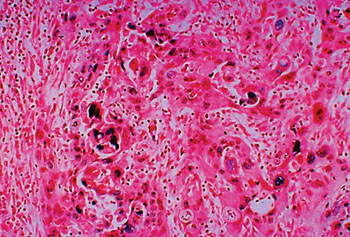Human Papillomavirus Infection Connected to Anal Cancer
By LabMedica International staff writers
Posted on 29 Feb 2016
The prevalence of abnormal anal cytology and high-risk human papillomavirus (HPV) among women with a history of HPV-related genital neoplasia with women without a history of HPV-related genital neoplasia has been compared. Posted on 29 Feb 2016
Anal cancer screening is routinely performed using anal cytology in human immunodeficiency virus (HIV) positive men and women, as well as in men having sex with men. Anal cancer is five times more likely in women with a history of cervical, vaginal or vulvar cancer, which are all linked to HPV.

Image: Immunohistochemistry showing in situ hybridization positive for human papilloma virus HPV16/18 in this anal carcinoma histology specimen (Photo courtesy of International Agency for Cancer Research).
Doctors at the Women & Infants Hospital (Providence, RI, USA) carried out a cross-sectional cohort study from December 2012 to February 2014. Women were recruited from outpatient clinics at an academic medical center. Women with a history of high-grade cervical, vulvar, or vaginal cytology, dysplasia, or cancer were considered the high-risk group. Women with no history of high-grade anogenital dysplasia or cancer were considered the low-risk group. Human immunodeficiency virus–positive women were excluded. Anal cytology and HPV genotyping were performed. Women with abnormal anal cytology were referred for high-resolution anoscopy.
There were 190 women in the high-risk group and 83 in the low-risk group. The high-risk group was slightly older: 57 years compared with 47 years; 21.7% of low-risk women had abnormal anal cytology compared with 41.2% of high-risk women. High-risk HPV was detected in the anal canal of 1.2% of the low-risk group compared with 20.8% of the high-risk group. Among women who underwent anoscopy, no anal dysplasia was detected in the low-risk group, whereas 13.4% in the high-risk group had anal dysplasia with 4.2% having anal intraepithelial neoplasia 2 or greater.
The authors concluded that human immunodeficiency virus-negative women with a history of lower genital tract neoplasia are more likely to have positive anal cytology, anal high-risk HPV, and anal intraepithelial neoplasia. Anal cancer screening should be considered for these high-risk women. Katina Robison, MD, the lead author of the study said, “HPV is associated with anal cancer, which is more common among women. In 2014 alone, there were 7,200 cases of anal cancer noted and 4,500 of them are women. We believe that certain women with a history of an HPV-related genital infection would benefit greatly from anal cancer screening.” The study was originally published in the December 2015 issue of the journal Obstetrics & Gynecology.
Related Links:
Women & Infants Hospital




 assay.jpg)








